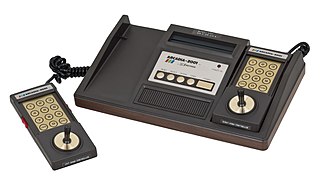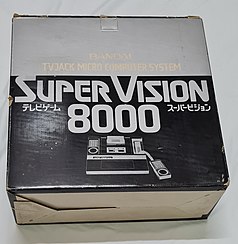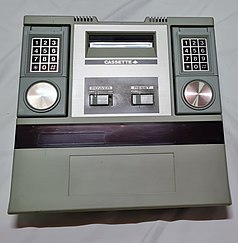
The Atari 5200 SuperSystem or simply Atari 5200 is a home video game console introduced in 1982 by Atari, Inc. as a higher-end complement for the popular Atari Video Computer System. The VCS was renamed to Atari 2600 at the time of the 5200's launch. Created to compete with Mattel's Intellivision, the 5200 wound up a direct competitor of ColecoVision shortly after its release. While the Coleco system shipped with the first home version of Nintendo's Donkey Kong, the 5200 included the 1978 arcade game Super Breakout, which had already appeared on previous Atari home platforms.

The Atari 7800 ProSystem, or simply the Atari 7800, is a home video game console officially released by Atari Corporation in 1986 as the successor to both the Atari 2600 and Atari 5200. It can run almost all Atari 2600 cartridges, making it one of the first consoles with backward compatibility. It shipped with a different joystick than the 2600-standard CX40 and included Pole Position II as the pack-in game. The European model has a gamepad instead of a joystick. Most of the early releases for the system are ports of 1981–1983 arcade video games. The final wave of 7800 cartridges are closer in style to what was available on other late 1980s consoles, such as Scrapyard Dog and Midnight Mutants.

The Arcadia 2001 is a second-generation 8-bit home video game console released by Emerson Radio in May 1982 for a price of US$ 99, several months before the release of ColecoVision. It was discontinued only 18 months later, with a total of 35 games having been released. Emerson licensed the Arcadia 2001 to Bandai, which released it in Japan. Over 30 Arcadia 2001 clones exist despite the system being a commercial failure.

The Game Boy Advance (GBA) is a 32-bit handheld game console, manufactured by Nintendo, which was released in Japan on March 21, 2001, and to international markets that June. It was later released in mainland China in 2004, under the name iQue Game Boy Advance. Compared to the Game Boy Color it replaced, the console offered far more powerful ARM7 processor and vastly improved graphics, while retaining backward compatibility with games initially developed for its predecessor.

The Intellivision is a home video game console released by Mattel Electronics in 1979. It distinguished itself from competitors with more realistic sports and strategic games. By 1981, Mattel Electronics had close to 20% of the domestic video game market, selling more than 3.75 million consoles and 20 million cartridges through 1983. At its peak Mattel Electronics had about 1800 employees in several countries, including 110 videogame developers. In 1984, Mattel sold its video game assets to a former Mattel Electronics executive and investors, eventually becoming INTV Corporation. Game development ran from 1978 to 1990, when the Intellivision was discontinued.

The Playdia is a fifth-generation home video game console released exclusively in Japan in 1994 at the initial price of ¥24,800. It was intended for a young audience and, like many consoles of the era, was marketed more as a multimedia home entertainment system than as a dedicated gaming console, with anime quiz software and edutainment making up most of the game library. The Playdia uses a single infrared joypad with simple controls. Bandai, the Playdia's manufacturer, was the only software publisher to support this console.

The RadioShack TRS-80 Color Computer, later marketed as the Tandy Color Computer, is a series of home computers developed and sold by Tandy Corporation. Despite sharing a name with the earlier TRS-80, the Color Computer is a completely different system and a radical departure in design based on the Motorola 6809E processor rather than the Zilog Z80 of earlier models.

The Bally Astrocade is a second-generation home video game console and simple computer system designed by a team at Midway, at that time the videogame division of Bally. It was originally announced as the "Bally Home Library Computer" in October 1977 and initially made available for mail order in December 1977. But due to production delays, the units were first released to stores in April 1978 and its branding changed to "Bally Professional Arcade". It was marketed only for a limited time before Bally decided to exit the market. The rights were later picked up by a third-party company, who re-released it and sold it until around 1984. The Astrocade is particularly notable for its very powerful graphics capabilities for the time of release, and for the difficulty in accessing those capabilities.

The Matra & Hachette Ordinateur Alice is a home computer sold in France beginning in 1983. It was a clone of the TRS-80 MC-10, produced through a collaboration between Matra and Hachette in France and Tandy Corporation in the United States.

The FM Towns is a Japanese personal computer built by Fujitsu from 1989 to 1997. It started as a proprietary PC variant intended for multimedia applications and PC games, but later became more compatible with IBM PC compatibles. In 1993, the FM Towns Marty was released; it is a game console compatible with existing FM Towns games.

The TMS9918 is a video display controller (VDC) manufactured by Texas Instruments, in manuals referenced as "Video Display Processor" (VDP) and introduced in 1979. The TMS9918 and its variants were used in the ColecoVision, CreatiVision, Memotech MTX, MSX, NABU Personal Computer, SG-1000/SC-3000, Spectravideo SV-318, SV-328, Sord M5, Tatung Einstein, TI-99/4, Casio PV-2000, Coleco Adam, Hanimex Pencil II, PECOS and Tomy Tutor.

The PC Engine SuperGrafx, also known as simply the SuperGrafx, is a fourth-generation home video game console manufactured by NEC Home Electronics and released in Japan in 1989. It is the successor system to the PC Engine, released two years prior. Originally known as the PC Engine 2 during production stages, it was purported as a true 16-bit home console, featuring improved graphics and audio capabilities over its predecessor.

The Cassette Vision is a second generation home video game console made by Epoch Co. and released in Japan on July 30, 1981. A redesigned model called the Cassette Vision Jr. was released afterwards.

The Coleco Gemini is an Atari 2600 clone manufactured by Coleco Industries, Inc. in 1983.
Namco Museum is a series of video game compilations developed and published by Bandai Namco Entertainment for home video game consoles. The first title in the series, Namco Museum Vol. 1, was released for the PlayStation in 1995. Entries in the series have been released for multiple platforms, including the Game Boy Advance, PlayStation 2, PlayStation Portable, Nintendo DS and Xbox 360. the latest being Namco Museum Archives Vol. 2, released in 2020.

The VTech CreatiVision is a hybrid computer and home video game console introduced by VTech in 1981 and released in 1982 during the second generation of video game consoles. It cost $295 Australian Dollars in Australia. The hybrid unit was similar in concept to computers such as the APF Imagination Machine, the older VideoBrain Family Computer, and to a lesser extent the Intellivision game console and Coleco Adam computer, all of which anticipated the trend of video game consoles becoming more like low-end computers. It was discontinued in 1986.

The APF Microcomputer System is a second generation 8-bit cartridge-based home video game console released in October 1978 by APF Electronics Inc. with six cartridges. The console is often referred to M-1000 or MP-1000, which are the two model numbers of the console. The APF-MP1000 comes built-in with the game Rocket Patrol. The APF-MP1000 is a part of the APF Imagination Machine. The APF-MP1000 and the APF Imagination Machine were developed in part by the noted engineer Ed Smith.

The original ZX Spectrum computer produces a one bit per pixel, bitmapped colour graphics video output. A composite video signal is generated through an RF modulator, and was designed for use with contemporary 1980s television sets.

The Super Cassette Vision is a home video game console made by Epoch Co. and released in Japan on July 17, 1984, and in Europe, specifically France, later in 1984. A successor to the Cassette Vision, it competed with Nintendo's Family Computer and Sega's SG-1000 line in Japan.

The Gakken Compact Vision TV Boy is a second generation home video game console developed by Gakken and released in Japan in 1983 for a price of ¥8,800.





















